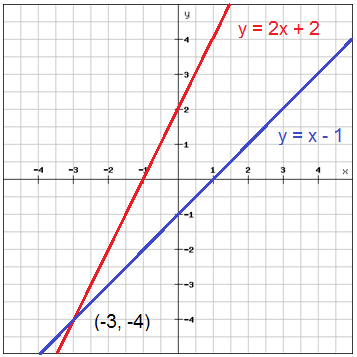How to Solve System of Equations by Graphing – A system of linear equations is a system made up of two linear equations. To solve the system of equations, you need to find the exact values of x and y that will solve both equations. One good way to do this is to graph each line and see where they intersect.
Before you can graph a linear equation, you need to make sure that it is written in slope-intercept form:
The slope-intercept form of a linear equation is: y = mx + b.
In slope-intercept form, m is the slope of the line and b is the y-intercept, so in the equation we looked at earlier, y = 3x + 5, the slope would be 3 and the y-intercept would be 5.
In Solving Linear Equations and Inequalities we learned how to solve linear equations with one variable. Remember that the solution of an equation is a value of the variable that makes a true statement when substituted into the equation.
Now we will work with systems of linear equations, two or more linear equations grouped together. System of Linear Equations
When two or more linear equations are grouped together, they form a system of linear equations.
We will focus our work here on systems of two linear equations in two unknowns. Later, you may solve larger systems of equations.
An example of a system of two linear equations is shown below. We use a brace to show the two equations are grouped together to form a system of equations.
A linear equation in two variables, like 2x + y = 7, has an infinite number of solutions. Its graph is a line. Remember, every point on the line is a solution to the equation and every solution to the equation is a point on the line.
To solve a system of two linear equations, we want to find the values of the variables that are solutions to both equations. In other words, we are looking for the ordered pairs (x, y) that make both equations true. These are called the solutions to a system of equations. Solutions of a System of Equations
Solutions of a system of equations are the values of the variables that make all the equations true. A solution of a system of two linear equations is represented by an ordered pair (x, y).
To determine if an ordered pair is a solution to a system of two equations, we substitute the values of the variables into each equation. If the ordered pair makes both equations true, it is a solution to the system.
Let’s consider the system below:
Is the ordered pair a solution?

The ordered pair (2, −1) made both equations true. Therefore (2, −1) is a solution to this system.
Let’s try another ordered pair. Is the ordered pair (3, 2) a solution?

The ordered pair (3, 2) made one equation true, but it made the other equation false. Since it is not a solution to both equations, it is not a solution to this system.
Determine whether the ordered pair is a solution to the system:
ⓐⓑ
Solution
- ⓐ
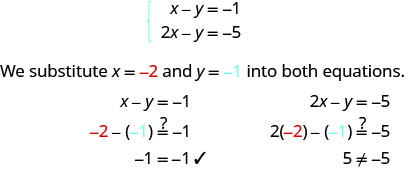
(−2, −1) does not make both equations true. (−2, −1) is not a solution.
ⓑ
(−4, −3) does not make both equations true. (−4, −3) is a solution.
Determine whether the ordered pair is a solution to the system:
ⓐⓑ
ⓐ yes ⓑ no
Determine whether the ordered pair is a solution to the system:
ⓐⓑ
ⓐ no ⓑ yes
Solve a System of Linear Equations by Graphing
In this chapter we will use three methods to solve a system of linear equations. The first method we’ll use is graphing.
The graph of a linear equation is a line. Each point on the line is a solution to the equation. For a system of two equations, we will graph two lines. Then we can see all the points that are solutions to each equation. And, by finding what the lines have in common, we’ll find the solution to the system.
Most linear equations in one variable have one solution, but we saw that some equations, called contradictions, have no solutions and for other equations, called identities, all numbers are solutions.
Similarly, when we solve a system of two linear equations represented by a graph of two lines in the same plane, there are three possible cases, as shown in (Figure):

For the first example of solving a system of linear equations in this section and in the next two sections, we will solve the same system of two linear equations. But we’ll use a different method in each section. After seeing the third method, you’ll decide which method was the most convenient way to solve this system. How to Solve a System of Linear Equations by Graphing
Solve the system by graphing: Solution
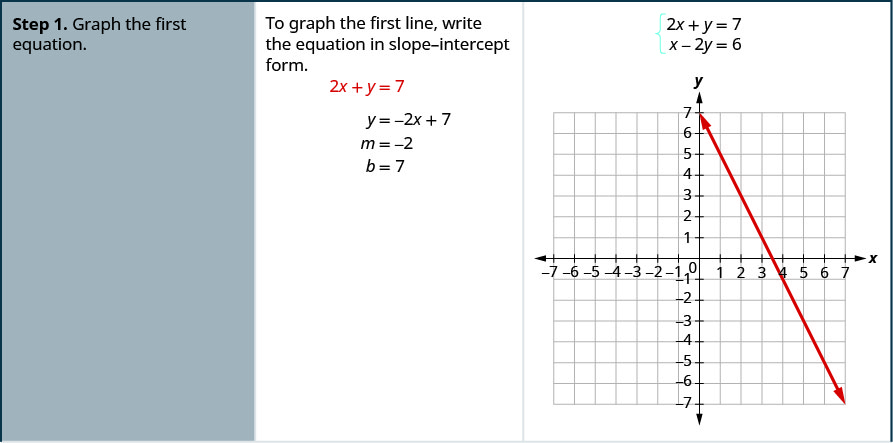


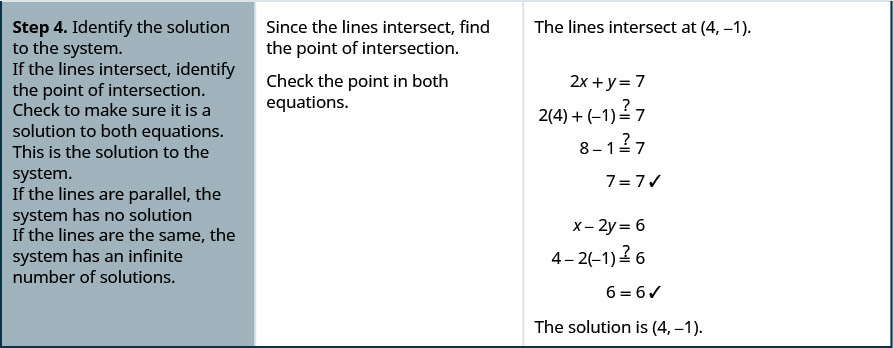
Solve each system by graphing:
Solve each system by graphing:
The steps to use to solve a system of linear equations by graphing are shown below. To solve a system of linear equations by graphing.
- Graph the first equation.
- Graph the second equation on the same rectangular coordinate system.
- Determine whether the lines intersect, are parallel, or are the same line.
- Identify the solution to the system.
- If the lines intersect, identify the point of intersection. Check to make sure it is a solution to both equations. This is the solution to the system.
- If the lines are parallel, the system has no solution.
- If the lines are the same, the system has an infinite number of solutions.
Solve the system by graphing: Solution
Both of the equations in this system are in slope-intercept form, so we will use their slopes and y-intercepts to graph them.
| Find the slope and y-intercept of the first equation. |  |
| Find the slope and y-intercept of the first equation. |  |
| Graph the two lines. | |
| Determine the point of intersection. | The lines intersect at (1, 3). |
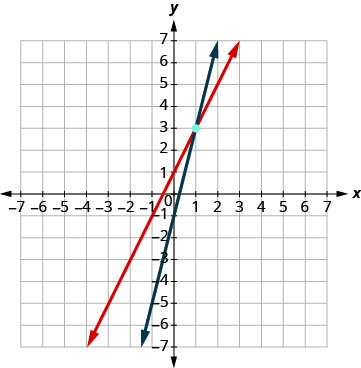 | |
| Check the solution in both equations. | |
| The solution is (1, 3). |
Solve each system by graphing:
Solve each system by graphing:
Both equations in (Figure) were given in slope–intercept form. This made it easy for us to quickly graph the lines. In the next example, we’ll first re-write the equations into slope–intercept form.
Solve the system by graphing: Solution
We’ll solve both of these equations for so that we can easily graph them using their slopes and y-intercepts.
| Solve the first equation for y. Find the slope and y-intercept. Solve the second equation for y. Find the slope and y-intercept. | |
| Graph the lines. | 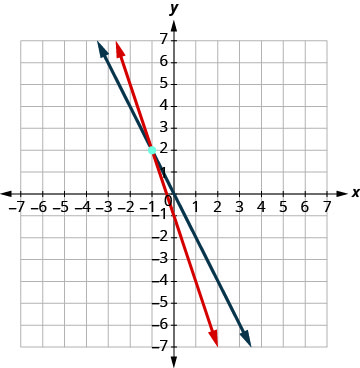 |
| Determine the point of intersection. | The lines intersect at (−1, 2). |
| Check the solution in both equations. | |
| The solution is (−1, 2). |
Solve each system by graphing:
Solve each system by graphing:
Usually when equations are given in standard form, the most convenient way to graph them is by using the intercepts. We’ll do this in (Figure).
Solve the system by graphing: Solution
We will find the x– and y-intercepts of both equations and use them to graph the lines.
 | ||
| To find the intercepts, let x = 0 and solve for y, then let y = 0 and solve for x. |  | |
 | ||
| To find the intercepts, let x = 0 then let y = 0. |  | |
| Graph the line. | 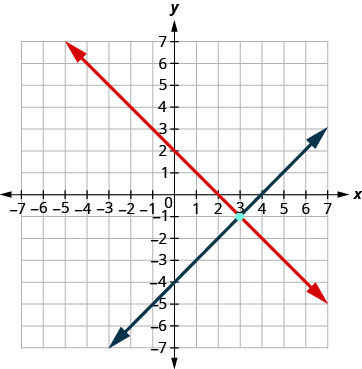 | |
| Determine the point of intersection. | The lines intersect at (3, −1). | |
| Check the solution in both equations. | The solution is (3, −1). |
Solve each system by graphing:
Solve each system by graphing:
Do you remember how to graph a linear equation with just one variable? It will be either a vertical or a horizontal line.
Solve the system by graphing: Solution
 | |
| We know the first equation represents a horizontal line whose y-intercept is 6. |  |
| The second equation is most conveniently graphed using intercepts. |  |
| To find the intercepts, let x = 0 and then y = 0. |  |
| Graph the lines. |  |
| Determine the point of intersection. | The lines intersect at (−3, 6). |
| Check the solution to both equations. | |
| The solution is (−3, 6). |
Solve each system by graphing:
Solve each system by graphing:
In all the systems of linear equations so far, the lines intersected and the solution was one point. In the next two examples, we’ll look at a system of equations that has no solution and at a system of equations that has an infinite number of solutions.
Solve the system by graphing: Solution
 | |
| To graph the first equation, we will use its slope and y-intercept. |  |
 | |
 | |
| To graph the second equation, we will use the intercepts. |  |
 | |
| Graph the lines. | 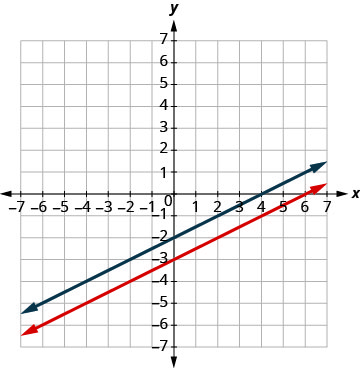 |
| Determine the point of intersection. | The lines are parallel. |
| Since no point is on both lines, there is no ordered pair that makes both equations true. There is no solution to this system. |
Solve each system by graphing:
no solution
Solve each system by graphing:
no solution
Solve the system by graphing: Solution
 | |
| Find the slope and y-intercept of the first equation. |  |
| Find the intercepts of the second equation. |  |
 | |
| Graph the lines. | 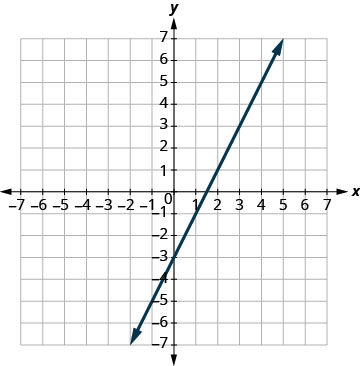 |
| Determine the point of intersection. | The lines are the same! |
| Since every point on the line makes both equations true, there are infinitely many ordered pairs that make both equations true. | |
| There are infinitely many solutions to this system. |
Solve each system by graphing:
infinitely many solutions
Solve each system by graphing:
infinitely many solutions
If you write the second equation in (Figure) in slope-intercept form, you may recognize that the equations have the same slope and same y-intercept.
When we graphed the second line in the last example, we drew it right over the first line. We say the two lines are coincident. Coincident lines have the same slope and same y-intercept. Coincident Lines
Coincident lines have the same slope and same y-intercept.
Determine the Number of Solutions of a Linear System
There will be times when we will want to know how many solutions there will be to a system of linear equations, but we might not actually have to find the solution. It will be helpful to determine this without graphing.
We have seen that two lines in the same plane must either intersect or are parallel. The systems of equations in (Figure) through (Figure) all had two intersecting lines. Each system had one solution.
A system with parallel lines, like (Figure), has no solution. What happened in (Figure)? The equations have coincident lines, and so the system had infinitely many solutions.
We’ll organize these results in (Figure) below:

Parallel lines have the same slope but different y-intercepts. So, if we write both equations in a system of linear equations in slope–intercept form, we can see how many solutions there will be without graphing! Look at the system we solved in (Figure).
The two lines have the same slope but different y-intercepts. They are parallel lines.
(Figure) shows how to determine the number of solutions of a linear system by looking at the slopes and intercepts.

Let’s take one more look at our equations in (Figure) that gave us parallel lines.
When both lines were in slope-intercept form we had:
Do you recognize that it is impossible to have a single ordered pair that is a solution to both of those equations?
We call a system of equations like this an inconsistent system. It has no solution.
A system of equations that has at least one solution is called a consistent system. Consistent and Inconsistent Systems
A consistent system of equations is a system of equations with at least one solution.
An inconsistent system of equations is a system of equations with no solution.
We also categorize the equations in a system of equations by calling the equations independent or dependent. If two equations are independent equations, they each have their own set of solutions. Intersecting lines and parallel lines are independent.
If two equations are dependent, all the solutions of one equation are also solutions of the other equation. When we graph two dependent equations, we get coincident lines. Independent and Dependent Equations
Two equations are independent if they have different solutions.
Two equations are dependent if all the solutions of one equation are also solutions of the other equation.
Let’s sum this up by looking at the graphs of the three types of systems. See (Figure) and (Figure).


Without graphing, determine the number of solutions and then classify the system of equations: Solution
| We will compare the slopes and intercepts of the two lines. | |
| The first equation is already in slope-intercept form. | |
| Write the second equation in slope-intercept form. | |
| Find the slope and intercept of each line. | |
| Since the slopes are the same and |
A system of equations whose graphs are parallel lines has no solution and is inconsistent and independent.
Without graphing, determine the number of solutions and then classify the system of equations.
no solution, inconsistent, independent
Without graphing, determine the number of solutions and then classify the system of equations.
no solution, inconsistent, independent
Without graphing, determine the number of solutions and then classify the system of equations: Solution
| We will compare the slope and intercepts of the two lines. | ||
| Write both equations in slope-intercept form. | ||
| Find the slope and intercept of each line. | ||
| Since the slopes are different, the lines intersect. |
A system of equations whose graphs are intersect has 1 solution and is consistent and independent.
Without graphing, determine the number of solutions and then classify the system of equations.
one solution, consistent, independent
Without graphing, determine the number of solutions and then classify the system of equations.
one solution, consistent, independent
Without graphing, determine the number of solutions and then classify the system of equations. Solution
| We will compare the slopes and intercepts of the two lines. | |
| Write the first equation in slope-intercept form. | |
| The second equation is already in slope-intercept form. | |
| Since the slopes are the same, they have the same slope and same |
A system of equations whose graphs are coincident lines has infinitely many solutions and is consistent and dependent.
Without graphing, determine the number of solutions and then classify the system of equations.
infinitely many solutions, consistent, dependent
Without graphing, determine the number of solutions and then classify the system of equations.
infinitely many solutions, consistent, dependent
Conclusion
In order to investigate situations such as that of the skateboard manufacturer, we need to recognize that we are dealing with more than one variable and likely more than one equation. A system of linear equations consists of two or more linear equations made up of two or more variables such that all equations in the system are considered simultaneously.
